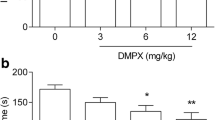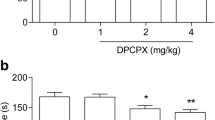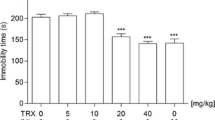Summary
The effect of repeated treatment (twice a day for 14 days) with antidepressant drugs (AD): imipramine, amitriptyline, zimelidine, citalopram and mianserin on the behavioural response to apomorphine in rats (open field test) was investigated. AD studied, given alone in a single dose or repeatedly, do not change the rats behaviour. A repeated but not single-dose treatment with AD facilitates the behaviour stimulation induced by apomorphine. This facilitation is observed 2 hours after the last dose of imipramine, zimelidine, citalopram and mianserin but 72 hours after the last dose of amitriptyline.
The results presented suggest that the AD given repeatedly are able to increase the responsiveness of the brain DA system, probably the mesolimbic one.
Similar content being viewed by others
References
Arnt, J., Hyttel, J., Fredricson Overø, K.: Prolonged treatment with the specific 5-HT uptake inhibitor citalopram: effect on dopaminergic and serotonergic functions. Pol. J. Pharmacol. Pharm.36, 217–226 (1984).
Chiodo, L. A., Antelman, S. M.: Repeated tricyclics induce a progressive dopamine autoreceptor subsensitivity independent of daily drug treatment. Nature (Lond.)287, 451–454 (1980).
Delini-Stula, A., Vassout, A.: Modulation of dopamine-mediated behavioural responses by antidepressants. Effects of single and repeated treatment. Eur. J. Pharmacol.58, 443–451 (1979).
Green, A. R., Deakin, J. F. W.: Brain noradrenaline depletion prevents ECS-induced enhancement of serotonin- and dopamine-mediated behaviour. Nature (Lond.)285, 232–233 (1980).
Green, A. R., Heal, D. J., Johnson, P., Laurence, B. E., Nimgaonkar, V. L.: Antidepressant treatments: effects in rodents on dose-response curves of 5-hydroxytryptamine- and dopamine-mediated behaviours and 5-HT2 receptor number in frontal cortex. Br. J. Pharmacol.80, 377–385 (1983).
Hyttel, J.: Citalopram-pharmacological profile of a specific serotonin uptake inhibitor with antidepressant activity. Prog. Neuropsychopharmacol. Biol. Psychiatr.6, 277–295 (1982).
Janssen, P. A. J., Jageneau, A. H. M., Schellekens, K. H. L.: Chemistry and pharmacology of compounds related to 4-(4-hydroxy-4-phenylpiperidino)-butyrophenone. Part. IV. Influence of haloperidol (R 1625) and of chlorpromazine on the behaviour of rats in an unfamiliar “open field” situation. Psychopharmacol. (Berl.)1, 389–392 (1960).
Karobath, M. E.: Tricyclic antidepressive drugs and dopamine-sensitive adenylate cyclase from rat brain striatum. Eur. J. Pharmacol.30, 159–163 (1975).
MacNeil, D. A., Gower, M.: Do antidepressants induce dopamine autoreceptor subsensitivity? Nature (Lond.)298, 302 (1982).
Maj, J., Mogilnicka, E., Klimek, V.: Dopaminergic stimulation enhances the utilization of noradrenaline in the central nervous system. J. Pharm. Pharmacol.29, 569–570 (1977).
Maj, J., Mogilnicka, E., Kordecka, A.: Chronic treatment with antidepressant drugs: potentiation of apomorphine-induced aggressive behaviour in rats. Neurosci. Lett.13, 337–341 (1979).
Maj, J., Mogilnicka, E., Kordecka-Magiera, A.: Effects of chronic administration of antidepressant drugs on aggressive behavior induced by clonidine in mice. Pharmacol. Biochem. Behav.13, 153–154 (1980).
Maj, J., Mogilnicka, E., Klimek, V., Kordecka-Magiera, A.: Chronic treatment with antidepressants: potentiation of clonidine-induced aggression in mice via noradrenergic mechanism. J. Neural Transm.52, 189–197 (1981).
Maj, J., Rogóz, Z., Skuza, G., Sowińska, H.: Effects of chronic treatment with antidepressants on aggressiveness induced by clonidine in mice. J. Neural Transm.55, 19–25 (1982).
Maj, J., Rogóz, Z., Skuza, G.: (+)-Oxaprotiline but not (−)-oxaprotiline given chronically potentiates the aggressive behaviour induced by clonidine. J. Pharm. Pharmacol.35, 180–181 (1983).
Maj, J., Rogóz, Z., Skuza, G., Sowińska, H.: Repeated treatment with antidepressant drugs potentiates the locomotor response to (+)-amphetamine. J. Pharm. Pharmacol.36, 127–130 (1984 a).
Maj, J., Rogóz, Z., Skuza, G., Sowińska, H.: The effects of repeated treatment with antidepressant drugs on the action of D-amphetamine and apomorphine in rats. Neuropharmacology85, Hungarian Academy of Sciences (in press, 1984 b).
Martin-Iverson, M. T., Leckre, J.-F., Fibiger, H.: Cholinergic-dopaminergic interactions and the mechanisms of action of antidepressants. Eur. J. Pharmacol.94, 193–201 (1983).
Melzacka, M., Danek, L.: Pharmacokinetics of amitriptyline N-oxide in rats after single and prolonged oral administration. Pharmacopsychiatria16, 30–34 (1983).
Morpurgo, C.: Aggressive behavior induced by large doses of 2-(2, 6-dichlorphenyl-amino)-2-imidazoline hydrochloride (St 155) in mice. Eur. J. Pharmacol.3, 374–378 (1968).
Neal, H., Bradley, P. B.: Electrocortical changes in the encéphale isolé cat following chronic treatment with antidepressant drugs. Neuropharmacol.18, 611–615 (1979).
Peroutka, S. J., Snyder, S. H.: Long-term antidepressant treatment decreases spiroperidol-labeled serotonin receptor binding. Science210, 88–90 (1980).
Przegaliński, E., Baran, L., Siwanowicz, J.: The effect of chronic treatment with antidepressant drugs on salbutamol-induced hypoactivity in rats. Psychopharmacol.80, 355–359 (1983).
Przegaliński, E., Baran, L., Siwanowicz, J., Bigajska, K.: Repeated treatment with antidepressant drugs prevents salbutamol-induced hypoactivity in rats. Pharmacol. Biochem. Behav. (in press, 1984).
Randrup, A., Braestrup, C.: Uptake inhibition of biogenic amines by newer antidepressant drugs: relevance to the dopamine hypothesis of depression. Psychopharmacol.53, 309–314 (1977).
Randrup, A., Munkvad, I., Fog, R., Gerlach, J., Molander, L., Kjellberg, B., Scheel-Krüger, J.: Mania, depression and brain dopamine. In: Current Developments in Psychopharmacology (Essman, W. B., Valzelli, L., eds.), Vol. 2, pp. 206–248. New York: Spectrum. 1975.
Ross, S. B., Hall, H., Reney, A. L., Westerlund, D.: Effects of zimelidine on serotoninergic and noradrenergic neurons after repeated administration in the rat. Psychopharmacol.72, 219–225 (1981).
Serra, G., Argiolas, A., Klimek, V., Fadda, F., Gessa, G. L.: Chronic treatment with antidepressants prevents the inhibitory effect of small doses of apomorphine on dopamine synthesis and motor activity. Life Sci.25, 415–424 (1979).
Snyder, S. H., Peroutka, S. J.: A possible role of serotonin receptors in antidepressant drug action. Pharmacopsychiatria15, 131–134 (1982).
Spyraki, C., Fibiger, H. C.: Behavioural evidence for supersensitivity of post-synaptic dopamine receptors in the mesolimbic system after chronic administration of desipramine. Eur. J. Pharmacol.74, 195–206 (1981).
Tang, S. W., Seeman, P., Kwan, S.: Differential effect of chronic desipramine and amitriptyline treatment on rat brain adrenergic and serotonergic receptors. Psychiatry Res.4, 129–138 (1981).
van Riezen, H., Pinder, R. M., Nickolson, V. J., Hobbelen, P., Zayed, I., van Der Veen, F.: Mianserin: a really different anti-depressant. In: Pharmacological and Biochemical Properties of Drug Substances (Goldberg, M. E., ed.), pp. 1–38. Washington: American Pharmaceutical Association. 1981.
Welch, J., Kim, H., Fallon, S., Liebman, J.: Do antidepressants induce dopamine autoreceptor subsensitivity? Nature (Lond.)298, 301–302 (1982).
Westerink, B. H. C., Lejeune, B., Korf, J., van Praag, H. M.: On the significance of regional dopamine metabolism in the rat brain for the classification of centrally acting drugs. Eur. J. Pharmacol.42, 179–190 (1977).
Wedzony, K., Maj, J.: The effect of repeated treatment with imipramine on the locomotor hyperactivity induced in rats by amphetamine administered into the nucleus accumbens. 8th Congress of the Polish Pharmacological Society, Warsaw, 26–28 September 1983, Abstracts, P181.
Wielosz, M.: Increased sensitivity to dopaminergic agonists after repeated electroconvulsive shock (ecs) in rats. Neuropharmacol.20, 941–945 (1981).
Willer, P.: Dopamine and depression: a review of recent evidence. III. The effects of antidepressant treatments. Brain Res. Rev.6, 237–246 (1983).
Author information
Authors and Affiliations
Rights and permissions
About this article
Cite this article
Maj, J., Rogóż, Z., Skuza, G. et al. Repeated treatment with antidepressant drugs increases the behavioural response to apomorphine. J. Neural Transmission 60, 273–282 (1984). https://doi.org/10.1007/BF01249099
Received:
Revised:
Issue Date:
DOI: https://doi.org/10.1007/BF01249099




